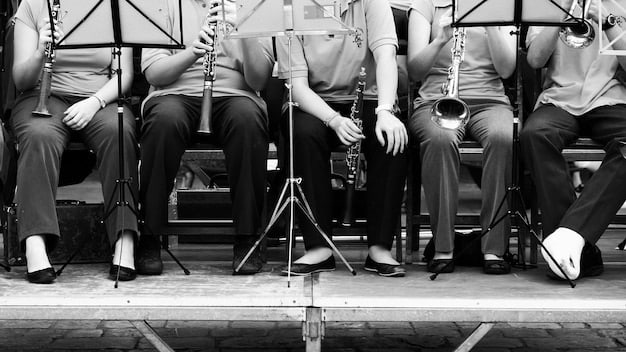Film Scores That Defined the 2010s: A Decade in Review

Film scores of the 2010s not only enhanced cinematic storytelling but also became cultural touchstones, reflecting and shaping the decade’s emotional and artistic landscape.
The 2010s were a transformative decade for cinema, and the film scores of that era played a crucial role in shaping the emotional impact and lasting legacy of many films. This retrospective review explores the film scores that defined a decade, highlighting the composers, techniques, and trends that made the 2010s a remarkable period for music in film.
The Rise of Hybrid Scoring
One of the defining characteristics of film scores in the 2010s was the blending of traditional orchestral arrangements with electronic and synthesized elements. This hybrid approach allowed composers to create richer, more complex soundscapes that enhanced the emotional depth of the films.
Hans Zimmer: The Master of Hybrid Scores
Hans Zimmer remained a dominant force in film scoring throughout the 2010s, with his work on films such as “Inception” and “Interstellar” setting new standards for hybrid scores. Zimmer’s ability to seamlessly integrate electronic textures with orchestral grandeur made his scores both epic and deeply personal.
Trent Reznor and Atticus Ross: Innovators in Sound Design
Trent Reznor and Atticus Ross also pushed the boundaries of film scoring in the 2010s with their ambient and experimental soundscapes. Their work on films like “The Social Network” and “Gone Girl” demonstrated how electronic music could be used to create a sense of unease and tension, perfectly complementing the narratives.
- “Inception” (2010): Zimmer’s use of distorted brass and pulsing electronic rhythms created a sense of disorientation and dreamlike atmosphere.
- “The Social Network” (2010): Reznor and Ross’s minimalist electronic score perfectly captured the cold, detached world of social media.
- “Mad Max: Fury Road” (2015): Junkie XL’s high-octane score combined orchestral elements with heavy electronic beats to create an intense and visceral experience.
- “Interstellar” (2014): Zimmer blended organ music with electronic soundscapes to amplify the film’s themes of time, space, and love, offering a profound emotional undercurrent.
The rise of hybrid scoring in the 2010s marked a significant shift in film music, reflecting a broader trend towards experimentation and innovation in cinematic soundscapes.
The Influence of Indie Cinema
Indie cinema experienced a renaissance in the 2010s, and its influence extended to film scoring. Many independent films featured innovative and unconventional scores that often eschewed traditional orchestral arrangements in favor of more experimental and intimate sounds.
Disasterpeace and “It Follows”
Disasterpeace’s score for the horror film “It Follows” became a cult classic for its eerie and unsettling soundscapes. Using synthesizers and electronic textures, Disasterpeace created a score that perfectly captured the film’s sense of dread and paranoia.
Jonny Greenwood and “There Will Be Blood”
Though released in 2007, Jonny Greenwood’s score for “There Will Be Blood” continued to resonate throughout the 2010s, influencing a new generation of composers. Greenwood’s dissonant and avant-garde score challenged traditional notions of film music, demonstrating how unconventional sounds could be used to enhance a film’s themes and emotions.

- “It Follows” (2014): Disasterpeace’s synth-driven score created a sense of relentless dread and paranoia.
- “Moonrise Kingdom” (2012): Alexandre Desplat’s whimsical score perfectly captured the film’s sense of childlike wonder and adventure.
- “Under the Skin” (2013): Mica Levi’s experimental score created a disorienting and unsettling atmosphere, reflecting the film’s themes of alienation and otherness.
The influence of indie cinema on film scoring in the 2010s was profound, paving the way for more experimental and unconventional approaches to music in film.
The Return of the Epic Score
While indie cinema embraced minimalism and experimentation, blockbuster films in the 2010s saw the return of the epic orchestral score. Composers like Michael Giacchino and John Powell delivered sweeping and emotionally resonant scores that harkened back to the golden age of film music.
Michael Giacchino: A Modern Maestro
Michael Giacchino emerged as one of the leading composers of epic scores in the 2010s, with his work on films such as “Star Trek” and “War for the Planet of the Apes.” Giacchino’s ability to craft memorable themes and orchestrate them with grandeur and emotion made his scores both thrilling and deeply moving.
John Powell and the “How to Train Your Dragon” Trilogy
John Powell’s scores for the “How to Train Your Dragon” trilogy stood out for their soaring melodies and vibrant orchestrations. Powell’s ability to capture the spirit of adventure and camaraderie made his scores an integral part of the films’ success.
- “Star Trek” (2009, 2013, 2016): Giacchino’s scores revitalized the franchise with bold, memorable themes.
- “How to Train Your Dragon” (2010, 2014, 2019): Powell’s Celtic-inspired melodies added depth and emotion to the animated trilogy.
- “The Hobbit” Trilogy (2012, 2013, 2014): Howard Shore’s return to Middle-earth provided consistency and thematic richness across the films.
The return of the epic score in the 2010s demonstrated the enduring power of orchestral music to create a sense of spectacle and emotional resonance in blockbuster films.
The Globalization of Film Music
The 2010s saw a greater globalization of film music, with composers from around the world bringing their unique cultural perspectives and musical traditions to Hollywood. This led to a more diverse and eclectic range of film scores, reflecting the increasingly global nature of cinema.
A.R. Rahman and “127 Hours”
A.R. Rahman, the acclaimed Indian composer, brought his distinctive blend of Indian classical music and Western pop to Danny Boyle’s “127 Hours.” Rahman’s score added a layer of spiritual transcendence to the film’s harrowing survival story.
Ludovico Einaudi and “This Is England”
Italian composer Ludovico Einaudi’s minimalist piano compositions gained widespread recognition in the 2010s, with his music featured in films such as “This Is England.” Einaudi’s evocative and emotionally resonant scores added a sense of intimacy and vulnerability to the films.
- “Life of Pi” (2012): Mychael Danna’s score blended Western and Indian musical elements, creating a vibrant and immersive soundscape.
- “Theeb” (2014): Nasser Shamma’s traditional Middle Eastern music added authenticity and cultural richness to the Jordanian film.
- “Embrace of the Serpent” (2015): Nascuy Linares created an ethereal soundscape using indigenous instruments and sounds from the Amazon rainforest.
The globalization of film music in the 2010s enriched the cinematic landscape, bringing new voices and perspectives to the art of film scoring.
The Evolution of Superhero Scores
Superhero films dominated the box office in the 2010s, and the scores for these films played a crucial role in shaping their tone and emotional impact. Composers like Alan Silvestri and Henry Jackman pushed the boundaries of superhero scores, creating music that was both epic and emotionally resonant.
Alan Silvestri and “The Avengers”
Alan Silvestri’s score for “The Avengers” became an instant classic, with its heroic themes and bombastic orchestrations. Silvestri’s score captured the spirit of teamwork and adventure, making it an integral part of the film’s success.
Henry Jackman and “Captain America: The Winter Soldier”
Henry Jackman’s score for “Captain America: The Winter Soldier” took a darker and more electronic approach, reflecting the film’s themes of espionage and political intrigue. Jackman’s score demonstrated how superhero music could be both exciting and intellectually stimulating.

- “The Avengers” (2012): Silvestri’s score delivered iconic themes that defined the superhero team.
- “Man of Steel” (2013): Zimmer’s powerful and operatic score reinvented the Superman mythos for a modern audience.
- “Guardians of the Galaxy” (2014): Tyler Bates blended classic rock anthems with orchestral elements, creating a fun and irreverent sonic landscape.
The evolution of superhero scores in the 2010s reflected the growing sophistication and complexity of the superhero genre, with composers pushing the boundaries of what superhero music could be.
Technological Advances and Film Scoring
Advances in technology played a significant role in shaping film scores in the 2010s. Composers had access to more sophisticated digital audio workstations, virtual instruments, and sampling libraries, allowing them to create more complex and detailed soundscapes.
The Impact of Virtual Instruments
Virtual instruments became an essential tool for film composers in the 2010s, allowing them to create realistic orchestral sounds without the need for a live orchestra. This made it possible for composers to work more quickly and efficiently, and to experiment with a wider range of sounds and textures.
The Rise of Modular Synthesis
Modular synthesis also experienced a resurgence in the 2010s, with composers using modular synthesizers to create unique and experimental sounds. Modular synthesis allowed composers to create custom patches and manipulate sounds in real-time, adding a new level of creativity and innovation to film scoring.
- DAWs (Digital Audio Workstations): Software like Pro Tools, Logic Pro, and Ableton Live became indispensable for composing, recording, and editing film scores.
- Sampling Technology: Advances in sampling allowed composers to create realistic and detailed virtual instruments.
- Software Synthesizers: Plugins like Serum, Massive, and Omnisphere offered composers vast sonic palettes and creative possibilities.
Technological advances transformed the landscape of film scoring in the 2010s, empowering composers with new tools and techniques for creating innovative and emotionally resonant music.
| Key Topics | Brief Descriptions |
|---|---|
| 🎶 Hybrid Scoring | Blending orchestral with electronic music. |
| 🎬 Indie Influence | Experimental scores in independent films. |
| 🦸 Superhero Music | Evolution of superhero film scores. |
| 🌍 Global Sounds | Globalization impacts film music. |
Frequently Asked Questions
▼
A hybrid score combines traditional orchestral elements with electronic and synthesized sounds, creating richer and more complex sonic textures for film.
▼
Indie cinema promoted unconventional and experimental scores, moving away from traditional orchestral arrangements in favor of more intimate and avant-garde sounds.
▼
Composers such as Michael Giacchino and John Powell were renowned for their sweeping and emotionally resonant orchestral scores in blockbuster films.
▼
Technological advances, including digital audio workstations and virtual instruments, allowed composers to create more detailed and complex soundscapes efficiently.
▼
Superhero scores became more sophisticated, blending epic orchestral music with electronic elements to mirror the growing complexity and tones of superhero narratives.
Conclusion
The film scores of the 2010s were a diverse and innovative reflection of the decade’s cinematic landscape. From hybrid scores to the influence of indie cinema and the globalization of film music, the 2010s were a remarkable period for music in film, shaping the emotional experience of cinema for years to come.





